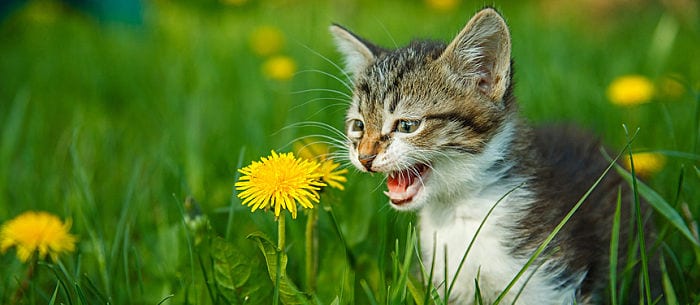You’re hearing all kinds of cat noises and are wondering what they mean. The range of sounds your kitty makes are called vocalizations and are part of her emotional expression, attitude and behavior. What sounds are common for cats to make?
Here are notable vocalizations and the likely meanings behind them:
- Chirp
You hear a birdlike chirp coming out of your cat. What’s the deal? “They will chirp when they see something desirable that they’re about to receive (like a meal or a treat),” says Francine Miller, an applied animal behavior counselor and the founder of Call Ms Behaving. - Trill
This vocalization sounds like a chirp, but according to Miller is “more musical.” Your cat trills to express happiness, explains Miller. Rita Reimers, a cat behavior consultant and the founder of The Cat Analyst. She also notes that a trill sound may also be used between cats as a “friendly greeting they make with one another.”
- Meow
It’s the quintessential kitty sound. The meow is typically vocalized for your benefit. “Generally, the ‘meow’ is reserved for talking with us and is not a noise you would usually hear cats using to communicate with one another,” says Reimers. It lets your cat tell you when he’s hungry, wants to go outside or just wants your attention.“My 17-year-old cat Sweet Pea will sit in the bathtub and call to me with new loud sharp meows until I come in to turn on the water for her,” says Reimers.
- Mew
It’s like a meow, but for kittens. Reimers explains, “One exception is the tiny kitten ‘mew’ noises you will hear young kittens making to their mothers.”
- Growl
This low growl or snarl may sound angry, but often means something else. “Generally a cat will show fear of external stimuli, such as another cat or a person. They usually produce the typical vocalizations people think of for an ‘angry’ cat — a growl, a hiss or a snarl,” says Miller.
- Purr
Does that engine-revving sound really mean your cat is over-the-moon happy? Miller says, “Sometimes. A purr is produced during times of contentment, but also when the cat is anxious. In anxious situations it may serve to self-soothe and also to calm an opponent. Cats may also purr when very sick or injured.”Reimers explains, “This is a throwback to their natural state when they are in the wild and serve as prey for other animals. A sick or injured cat is easy prey, therefore a cat will purr to communicate to their predator that they are not, in fact, in a weakened state even if they are.”
- Shriek
Fluffy got loose. She’s outside, it’s nighttime and you hear an earth-shattering shriek. Well, maybe it’s not exactly earth-shattering but it’s shrill and alarming to your ears. It’s likely that another cat or animal has surprised your cat and she’s poised for a possible altercation. “In extreme, aggressive encounters, a cat may shriek,” says Miller.
- Howl
There’s a howl coming from somewhere but you can’t pinpoint the exact origin. This type of vocalization is characteristic of a cat in distress, according to the Humane Society of the United States. Your cat may howl if he’s hurt and in pain or because he’s stuck in a sticky situation (like being locked in a kitchen cabinet or is disoriented due to old age or serious illness).A hearty howl may also accompany mating behavior in unspayed or unneutered animals. “A series of loud howls may indicate your female cat is in heat,” says Reimers.
- Hiss
“Cats will hiss to ward off an attack or to simply communicate to another cat that you are in his territory and you had better leave. It is a warning that you better leave now or face an attack,” says Reimers.
Now that you’re primed on cat noises, you’ll know exactly what your feline friend needs next time he comes yelling.
Erica Loop is the mom to one teenager, two Olde Boston Bulldogs and one very shy cat. She’s also a freelance writer, educator and the creator of the blog Mini Monets and Mommies.



